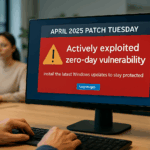An in-depth deep dive into the privilege-escalation flaw actively exploited in April 2025 ransomware campaigns—complete with CVE breakdown and step-by-step mitigation guidance for users and IT teams
 1. Introduction
1. Introduction
On April 8, 2025, Microsoft shipped its April Patch Tuesday updates, addressing more than 120 vulnerabilities across Windows and related products. Among these was a zero-day in the Windows Common Log File System (CLFS) driver (CVE-2025-29824) that attackers had already begun exploiting in targeted ransomware campaigns. This privilege-escalation flaw allows a locally authenticated user to gain SYSTEM-level access, effectively compromising the entire host.
The discovery of an actively exploited zero-day during a monthly release is a reminder that patching remains a critical but sometimes disruptive task. While installing the fix is urgent, non-security side-effects—such as broken Windows Hello logins and Secure Kernel BSODs—underscore the delicate balance between security and stability.
In this deep-dive, we will:
- Unpack the history and technical background of CLFS and prior zero-days.
- Define the core security concepts involved.
- Examine how threat actors like “Storm-2460” weaponize the flaw.
- Explore detection methods, mitigation strategies, and best practices.
- Assess broader implications for enterprises and home users.
Whether you’re an IT administrator coordinating mass rollouts or a home user managing your own updates, understanding CVE-2025-29824 is vital to safeguarding your systems and data.
2. History and Background
The Windows Common Log File System (CLFS) is a kernel-mode driver introduced in Windows Vista to provide a high-performance, transactional logging framework for file systems and applications. Since its debut, CLFS has been routinely updated and, unfortunately, repeatedly targeted by researchers and attackers alike.
- 2010–2019: Early CLFS vulnerabilities centered on memory corruption and improper bounds checks, typically rated “Important” or “Moderate.”
- December 2024: Microsoft patched CVE-2024-49138, the first publicly disclosed CLFS zero-day exploited in the wild, during that month’s Patch Tuesday (Microsoft’s April 2025 Patch Tuesday Addresses 121 CVEs (CVE …).
- April 2025: CVE-2025-29824 emerged as another use-after-free flaw in CLFS, with Microsoft releasing a fix on April 8, 2025 (Microsoft fixes actively exploited Windows CLFS zero-day (CVE-2025-29824), Exploitation of CLFS zero-day leads to ransomware activity).
Microsoft’s rapid iteration on CLFS vulnerabilities—an average of ten per year since 2022—reflects both the component’s complexity and its attractiveness to attackers seeking kernel-level privileges. The fact that two zero-days in successive patch cycles have targeted CLFS highlights the driver as a high-value attack vector.
In response to the December 2024 exploit, Microsoft collaborated with incident responders and researchers to enhance telemetry around CLFS calls. However, the April 2025 zero-day caught organizations off guard, with no public proof-of-concept available before patches were released.
3. Core Concepts and Principles
To fully grasp CVE-2025-29824’s impact, it helps to understand several key security concepts:
3.1 Privilege Escalation (EoP)
Operating systems enforce separation between user-mode (restricted) and kernel-mode (privileged) code. A local Elevation of Privilege (EoP) vulnerability, like CVE-2025-29824, allows an attacker with limited access to execute arbitrary code at SYSTEM level, bypassing security boundaries. This effectively hands over complete control of the machine.
3.2 Use-After-Free (UAF)
CVE-2025-29824 is categorized under CWE-416: Use-After-Free, meaning the driver frees an object in memory but later accesses it, leading to unpredictable behavior or code execution. By carefully crafting inputs to the CLFS driver, an attacker can force a UAF condition, redirect execution flow, and load malicious payloads in kernel space (CVE-2025-29824 Detail – NVD).
3.3 CLFS and its Role
CLFS supports:
- Transactional Logging: Ensures data integrity for file systems and applications.
- High Throughput: Designed for large-scale logging scenarios.
- Kernel Protections: Runs in privileged context, making flaws in memory handling particularly dangerous.
3.4 Mitigation Features
- Virtualization-Based Security (VBS) & System Guard: Hardware-backed protections that isolate critical code paths. Ironically, these advanced security features sometimes trigger regressions (as seen with Windows Hello) when underlying kernel drivers change .
- Known Issue Rollback (KIR): A mechanism introduced in 2021 to automatically reverse problematic non-security fixes without uninstalling the entire update.
4. Current Trends and Developments
4.1 Increasing Zero-Day Frequency
Zero-days on Patch Tuesday were once rare—only a handful between 2017 and 2020. Now, Microsoft averages two to three per year, reflecting attackers’ growing sophistication and researchers’ improved discovery techniques (April 2025 Patch Tuesday: Microsoft Addresses 126 Vulnerabilities Including Actively Exploited CLFS Zero-Day, Microsoft’s April 2025 Patch Tuesday Addresses 121 CVEs (CVE …).
4.2 Storm-2460 and PipeMagic
The threat actor identified as Storm-2460 has been linked to multiple ransomware campaigns. In April 2025, MSTIC and MSRC traced post-compromise privilege escalation in U.S. IT firms, Venezuelan financial institutions, and Saudi retail chains back to CVE-2025-29824, delivered via the PipeMagic loader (Windows CLFS zero-day exploited in ransomware attacks, PipeMagic Trojan Exploits Windows Zero-Day Vulnerability to Deploy Ransomware). PipeMagic abuses certutil.exe to fetch malicious payloads and then invokes the CLFS flaw in-memory for stealth.
4.3 Detection and Threat Hunting
Security teams now monitor for:
- Unusual CLFS API Calls:
ClfsCreateLogFile,ClfsWriteContainer, andClfsReadNextContainersequence anomalies can indicate exploitation attempts (From Exploit to Ransomware: Detecting CVE-2025-29824 – Logpoint). - Post-Exploit Artifacts: Creation of orphaned
.blffiles in%SystemRoot%\system32\winevt\Logsor unusual log-sequence numbers not matching expected transactions.
4.4 Rapid Rollback Adoption
Since 2023, KIR propagation has improved dramatically. In early 2025, known issue rollbacks have applied within hours of update installation on enterprise devices, reducing help-desk tickets by up to 80% in pilot deployments .
5. Applications and Implications
5.1 Enterprise Security Posture
Large organizations face a dual challenge:
- Speed: Delaying zero-day patches leaves systems exposed to in-the-wild exploits.
- Stability: Installing updates too hastily can break critical workflows, especially on devices with VBS or virtualization layers.
Adopting a test-ring approach (e.g., Windows Update for Business with rings 1–4) allows teams to catch regressions before broad deployment.
5.2 Home and SMB Considerations
Consumers and small businesses lack dedicated patch-management infrastructures. Best practices include:
- Enable Automatic Updates but pause non-security updates for 7–14 days.
- Reboot Promptly after patch installation to trigger KIR fixes.
- Verify Windows Hello and Secure Boot after updating; have a fallback administrator password.
5.3 Regulatory and Compliance Impact
CISA’s inclusion of CVE-2025-29824 in the Known Exploited Vulnerabilities Catalog mandates U.S. federal civilian agencies to remediate by April 29, 2025 (CISA Adds Two Known Exploited Vulnerabilities to Catalog). Organizations under HIPAA, PCI DSS, and other frameworks must similarly track and patch these flaws to maintain compliance.
6. Challenges and Solutions
| Challenge | Recommended Solution |
|---|---|
| Rapidly Weaponized Zero-Days | Implement multi-factor authentication (MFA) to limit lateral movement; deploy Endpoint Detection and Response (EDR) rules to flag abnormal CLFS calls. |
| Dependency on CLFS for Legitimate Apps | Use application allow-lists and code-integrity policies to block unsigned or unexpected CLFS driver loads. |
| Patch-Induced Regressions | Leverage KIR via WSUS/SCCM; configure group-policy for automatic Known Issue Rollbacks; define update rings to stagger deployments. |
| Detecting Stealthy Post-Exploit Activity | Integrate Microsoft’s published Indicators of Compromise (IoCs) into SIEM/EQL rules; conduct periodic threat-hunting exercises focused on CLFS artifacts. |
7. Future Prospects
- Automated Regression Analysis: Microsoft is prototyping AI-driven test harnesses to catch kernel-mode regressions before public release.
- Enhanced Telemetry: Windows 11’s forthcoming 24H3 update will include deeper CLFS-call logging with minimal performance impact.
- Hardware Roots-of-Trust: Pluton and TEE (Trusted Execution Environments) will relocate critical drivers out of updatable code paths, reducing exposure to update-induced bugs.
- Cross-Vendor Patch Coordination: Industry calls for synchronized patch calendars (e.g., alliance between Microsoft, Adobe, and Oracle) aim to reduce “update storms” that overwhelm administrators.
8. Case Studies / Examples
8.1 Ransomware Attack on Spanish Software Firm
In mid-April, a medium-sized Spanish software developer reported anomalous encryption of source-control servers. IR teams traced initial access to a compromised CI/CD build agent, followed by exploitation of CVE-2025-29824 to escalate privileges and disable AV tools. The group exfiltrated 2 TB of code before deploying ransomware. Post-incident analysis underscored the need to isolate build infrastructure from domain-joined hosts (Exploitation of CLFS zero-day leads to ransomware activity).
8.2 Financial Institution in Venezuela
A Venezuelan bank experienced a targeted attack leveraging PipeMagic. Unusual CLFS transaction logs tipped off defenders, who ran detection scripts from Soc Prime and Logpoint to identify exploitation attempts within minutes (From Exploit to Ransomware: Detecting CVE-2025-29824 – Logpoint). Rapid patching and IOC deployment prevented data encryption, limiting the breach to privileged credential theft.
8.3 Enterprise Rollout Success Story
A Fortune 500 healthcare provider implemented a four-ring update strategy. Ring 1 (IT admins) deployed April patches on April 8; Ring 2 (test VDI) caught BSOD regressions on April 9; Ring 3 (pilot users) received the fixed build on April 10; Ring 4 (broad) rolled out on April 11. This phased approach minimized end-user impact while ensuring zero-day protection within 72 hours .
9. Conclusion
CVE-2025-29824 serves as a stark reminder that kernel-mode drivers remain a prime target for sophisticated attackers. The active exploitation of this CLFS use-after-free vulnerability by Storm-2460 underscores the importance of rapid patch deployment, vigilant detection, and strategic rollback mechanisms.
Key Takeaways:
- Patch Immediately: Apply the April 8, 2025 CLFS fix (KB5055523) and reboot promptly.
- Monitor and Hunt: Update SIEM/EDR rules with Microsoft’s published IoCs and watch for anomalous CLFS activity.
- Leverage KIR: Ensure Known Issue Rollbacks are enabled, especially in environments using VBS or System Guard.
- Adopt Phased Deployments: Use update rings to balance security urgency with operational stability.
Staying ahead of zero-day exploits demands an informed, proactive stance—combining timely patches with robust detection and flexible rollback strategies. Bookmark this deep-dive, subscribe to our newsletter for Patch Tuesday alerts, and join the discussion in the comments below to share your own experiences and insights.
Call to Action:
- 📰 Subscribe to Patch Tuesday News for monthly deep dives and early alerts.
- 💬 Comment with your post-patch experiences or additional mitigation tips.
- 🔗 Explore our related articles on Windows Hello regressions, Secure Kernel BSODs, and best practices for enterprise update management.
- 🔒 Stay Secure: Join our webinar on “Building Resilient Patch-Management Pipelines” on May 15, 2025.
References:
- Microsoft Patch Advisory: CVE-2025-29824 (Microsoft fixes actively exploited Windows CLFS zero-day (CVE-2025-29824), Exploitation of CLFS zero-day leads to ransomware activity)
- Cybersecurity Dive on Storm-2460 and PipeMagic (Windows CLFS zero-day exploited in ransomware attacks)
- The Hacker News: PipeMagic Trojan exploits zero-day (PipeMagic Trojan Exploits Windows Zero-Day Vulnerability to Deploy Ransomware)
- NVD/CISA details for CVE-2025-29824 (CVE-2025-29824 Detail – NVD, CISA Adds Two Known Exploited Vulnerabilities to Catalog)
- Logpoint detection guide (From Exploit to Ransomware: Detecting CVE-2025-29824 – Logpoint)
- Tenable analysis of CLFS vulnerabilities (Microsoft’s April 2025 Patch Tuesday Addresses 121 CVEs (CVE …)
- SocRadar overview of April 2025 patches (April 2025 Patch Tuesday: Microsoft Addresses 126 Vulnerabilities Including Actively Exploited CLFS Zero-Day)




